The diverse star jasmine is an eye-catcher at any time of the year - whether as a climbing plant, in a pot or as a bonsai. It enriches summer evenings with a gentle scent of jasmine and vanilla.
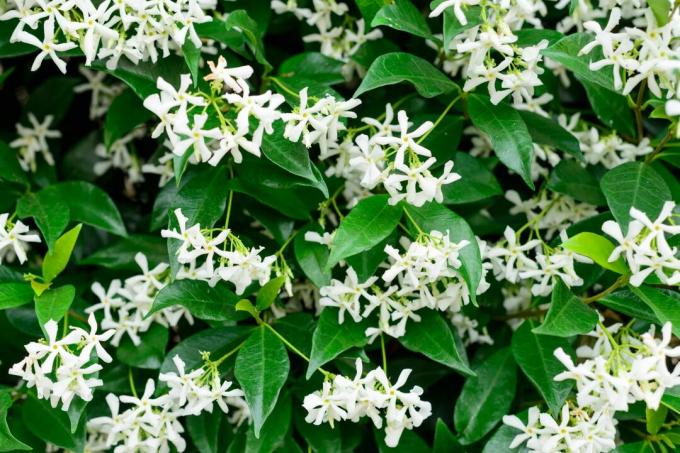
star jasmine (trachelosperum) inspires in summer with a beautiful sea of flowers and the almost beguiling scent. In winter, the evergreen plant is a ray of hope and brings the Mediterranean flair directly into your garden.
contents
- Star jasmine: origin and properties
- The most beautiful star jasmine types and varieties
- plants and location
- Caring for Star Jasmine: Cutting and Co.
- Is star jasmine hardy?
- propagation
- Is Star Jasmine Toxic?
Star jasmine: origin and properties
star jasmine (trachelospermum) is native to the tropical and subtropical regions of Asia. In Europe, the evergreen climbing shrub grows particularly well in the Mediterranean region and in wine-growing regions. Star jasmine is also very popular in Germany when cultivated as a container plant.
Star jasmine must not be mixed with real jasmine (Jasmine officinale) confound. Although this has quite similar properties, it is not an evergreen plant. The star jasmine belongs to the dogbane family (Apocynaceae), so despite the similarity it is not in the same family as the jasmine, which belongs to the olive tree family (Oleaceae).
The slow-growing star jasmine can grow up to 4 m high and, depending on the species and variety, forms white, pink or light yellow, star-shaped flowers. Characteristic is the jasmine-like, flowery, slightly sweet smell during flowering, which is emitted in the evening hours. The flowering time of the star jasmine is from April to August, with good care it can even come to a second flowering into September. The star jasmine is a liana-like, woody climbing plant. It forms oval, year-round green leaves on the side shoots, which – like the shoots – contain a white, poisonous milky sap.
The most beautiful star jasmine types and varieties
All types of star jasmine are similar - the main difference is the color of the flowers. The 4 classic star jasmine species and varieties are briefly presented here:
- Trachelospermum jasminoides: The white star jasmine is already a classic among connoisseurs and inspires with its scent.
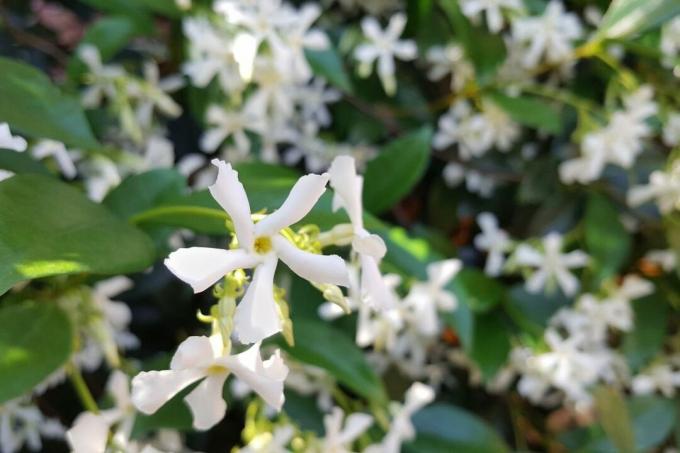
- Trachelospermum jasminoides ˈStar Of Tuscanyˈ: The numerous light yellow flowers of the Tuscan star jasmine exude the typical jasmine smell.
- Trachelospermum asiaticum: Yellow star jasmine is not as well known as white star jasmine, but is a little more cold tolerant and has cream to yellow flowers.
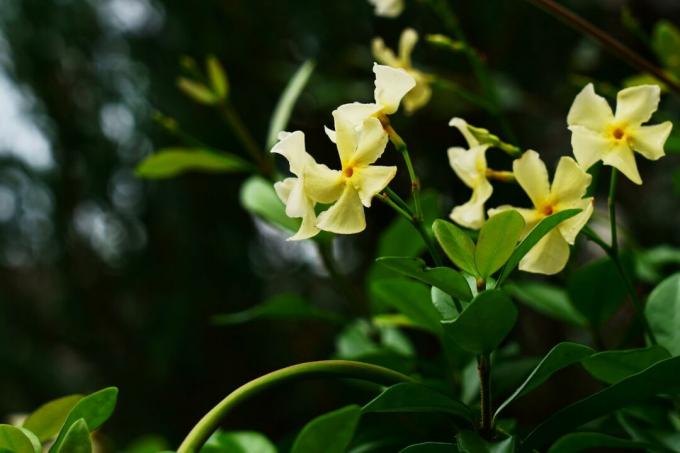
- Trachelospermum asiaticum ˈPink Airˈ: The pink star jasmine is a real gem due to its extraordinary flower coloration and forms a wonderful play of colors with the evergreen leaves.
plants and location
The star jasmine can be cultivated as a climbing plant or as a bonsai with the help of climbing aids, it is also often used as a ground cover. In Germany will trachelospermum almost always kept as a container plant, as the plant is conditionally hardy and only tolerates temperatures of -15 °C for short periods. When it comes to potting soil, you should use high-quality potting soil like ours Plantura organic potting soil be used. It is already pre-fertilized and provides your star jasmine with optimal nutrients for vigorous growth. In addition, up to 60% less CO is used in the production of our organic soil2 expelled because we deliberately avoid peat. The soil is best drained to avoid waterlogging. For this we recommend the addition of about 30% expanded clay.
Star jasmine needs a partially shaded or sunny spot. In winter it makes sense to shade it in a sunny location to avoid frost-dryness. It can also 'sunburn' the foliage in full sun, so a partially shaded location is preferable overall. The plant must be offered a trellis or a trellis if it is to climb up and hang down picturesquely.
You can read further down in this article at which location the star jasmine best spends the winter.
Tip: If the location of the star jasmine is chosen near a terrace or seating area, the vanilla-like scent comes into its own.
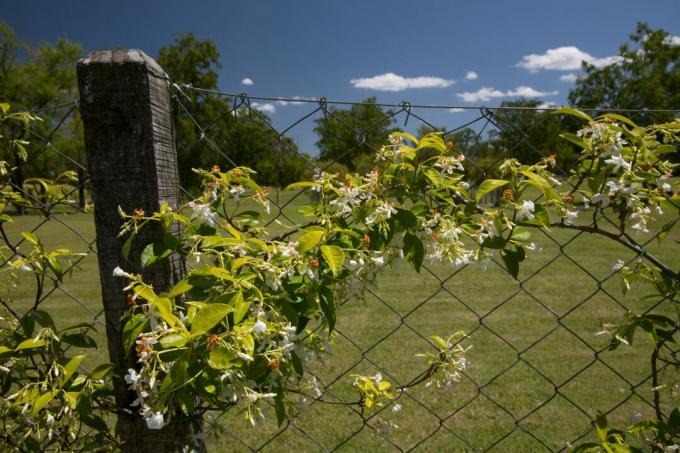
Caring for Star Jasmine: Cutting and Co.
The star jasmine needs a rather moist but not wet environment. Mulching ensures even soil moisture. A particularly long-lasting flowering can be achieved with an adequate supply of nutrients - for this you should fertilize with flowering plant fertilizer every 2 weeks between the months of April and November. If there is a lack of nutrients, flowering sometimes does not occur and growth is reduced. To prevent this, you can regularly add a liquid fertilizer like ours to the irrigation water Plantura organic flower & balcony fertilizer be admitted. This is tailored to the nutrient requirements of flowering plants and the potassium it contains supports resistance to many pathogens and frost hardiness. For a longer culture in the tub, we recommend a granular fertilizer such as ours, even at the beginning of the year Plantura organic flower fertilizer to be used to prevent phosphorus deficiency. In winter, on the other hand, fertilization is completely stopped.

Plantura organic flower & balcony fertilizer
Highly effective organic liquid fertilizer
with an NK ratio of 5-3
for all flowering and balcony plants,
safe for pets and garden animals
The star jasmine can be cut back before the onset of winter. In principle, however, no pruning is necessary - it is better to attach the star jasmine to the trellis and form it in this way.
In addition, potted plants should be transplanted into a slightly larger pot every 2 years.
Tip: Gloves should be worn when cutting as the milky juice that comes out is poisonous and can irritate the skin.
Brown leaves on star jasmine: what to do? Browning of the leaves often occurs after frost damage. The plant was kept at too low temperatures, as a result of which some leaves die off. Depending on how low the temperatures were and how long the star jasmine was exposed to the temperatures, it recovers more or less quickly. You can remove the brown leaves to help. Other causes can be waterlogging or sunburn from too much direct sunlight. Sunburn occurs mainly in early autumn because it is caused by the combination of sun and cold.
Is star jasmine hardy?
The star jasmine is only conditionally hardy. Therefore, if possible, the plant should be overwintered in a bright, frost-free place such as in a conservatory or in a shed at 3 to 18 °C. With star jasmine planted out in the garden, the winter sun draws moisture from the leaves, even on cold or frosty days. So that the plant does not dry out, the soil must always be sufficiently moist. If necessary, water in frost-free weather periods when the natural precipitation is not sufficient.
The power of the sun and thus the evaporation losses can be reduced by shading - for example with spruce branches hanging between the shoots. However, the materials used for shading should be air-permeable and somewhat translucent:
- Protect the root area with leaves and fir branches.
- Shade the entire climbing plant in an airy manner.
- Water little on frost-free days.
Tip: At the end of the hibernation, slowly acclimate the star jasmine to the sun to reduce the risk of sunburn.
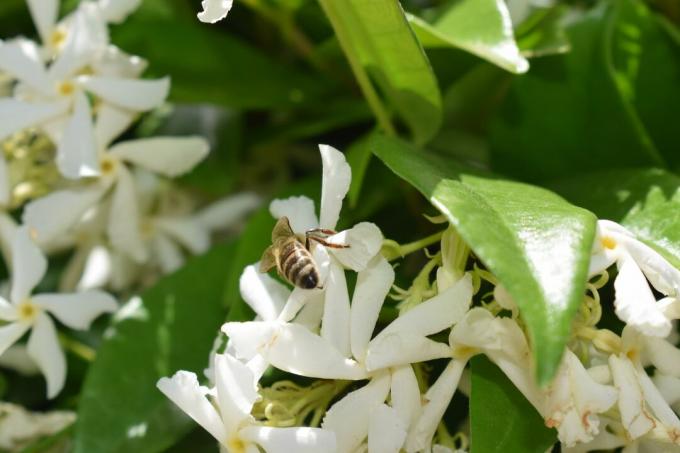
propagation
You can trachelospermum propagate by seed or cuttings. However, getting seeds is not that easy. Therefore, the cuttings propagation is often chosen. To do this, proceed as follows:
- In summer or autumn, after flowering, cut off 10 cm long, green or semi-ripe shoots from the main shoots.
- Stick them in potting soil.
- Ensure suitable temperatures of 15 - 20 °C.
- For better growth, cover the pot with the shoots with foil to achieve high humidity.
- Water the cuttings little and let the soil dry out from time to time.
- Rooted plants can be repotted in spring.
Tip: Propagation via layering is also possible in spring.
Is Star Jasmine Toxic?
Like many other dogbane plants, the star jasmine is very poisonous. The milky juice that comes out can be irritating for some people and lead to swelling, redness and rashes. The rest of the plant is also very poisonous to humans and animals. If consumed, a doctor must be consulted immediately. The well-scented star jasmine is therefore dangerous, especially for children, as the smell prompts them to try it.
Even in winter you can enjoy jasmine flowers - in our article on winter jasmine we will show you which location and which care the early bloomers need.
...and receive concentrated plant knowledge and inspiration directly in your e-mail inbox every Sunday!

